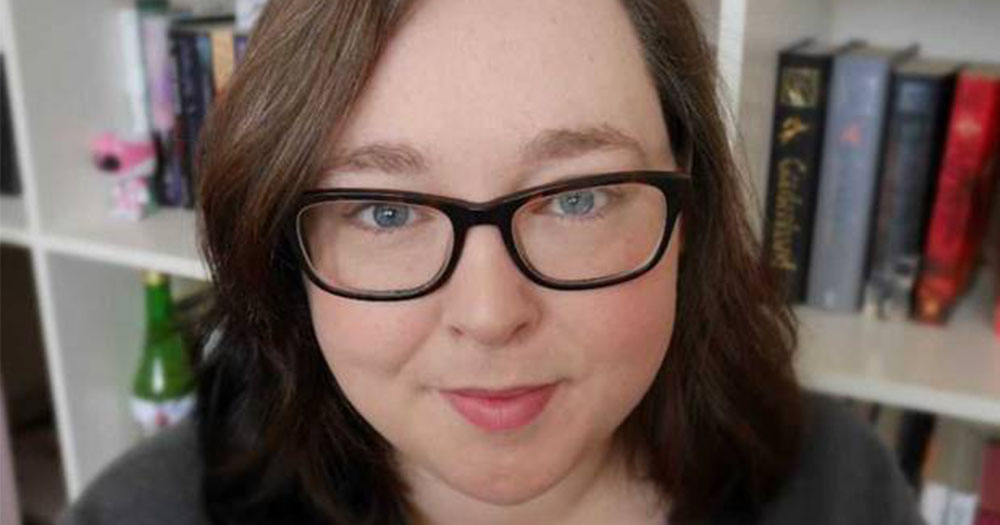Growing up I searched for myself in the books I read. My identity felt like a secret kept even from me, puzzle pieces scattered in the wind, a treasure hidden deep underground. Books were where I found myself, bit by bit. I found the dramatic side of me, the quiet side, the lonely side, the adventurous, the scared, the brave, the silly.
Each part of myself that I found on a page felt like a tiny victory, a reassurance that I was a person like any other, that I was part of us and not alone either. So I read and I read and I stored my found pieces close to my heart in the hopes that eventually when I had read enough, I would have found myself, I would understand myself, I would accept myself. But one part always seemed to escape my grasp.
I read all of the first kisses I could find, the first dates and first loves, and none of them slotted themselves into my missing piece. I swooned over Edward and Jacob and Harry and Ron but none of them felt quite right.
Something was off, something was missing. No matter how much I read and how hard I tried I couldn’t see myself in these characters or relationships. Then came a book with a pink cover and a salacious story.
When I was sixteen I found it in my favourite bookshop, bought it immediately and quietly and hid it, ironically, at the back of my closet. I only read it late at night, staying up to secretly reread it over and over again.
It was about a girl who falls in love with another girl, their friendship becoming a relationship, their kisses and fights and feelings, and messes. It was the closest I’d ever come to feeling truly, fully seen.
It wasn’t perfect – it was overly sexualised and not the most positive portrayal of young queer love, it painted a queer relationship as a secret to be kept rather than a fact to be accepted – but it meant everything to me.
When I came to write my own books, first a young adult book called The Space Between, and most recently my book for children, The Deepest Breath, I wanted to give readers a chance to encounter a queer character much earlier than I had.

The story follows eleven year-old Stevie. Stevie’s mum likes to joke that someday Stevie will marry her best friend Andrew, but Stevie knows that she doesn’t feel that way about Andrew. However, she does have feelings about someone else: her friend Chloe.
“It’s in my chest, and sometimes my tummy , and always my head it’s a fizzy feeling, and I don’t know what it is exactly.”
While I was writing Stevie and her story I kept thinking about what I wanted from books when I was a kid. I thought about the permissions books had granted me; how characters had shown me I could be brave, clever, a bookworm, an inventor, a pilot; and I wanted to show young readers what I hadn’t been shown: that I could be a girl who loves girls.
The importance of this permission can’t be overstated. Seeing yourself in the media you consume normalises your experience, helps you understand and accept those aspects of yourself that you see reflected.
It’s especially important for questioning kids to see their own identities represented in books and TV shows and movies to affirm that what they’re feeling isn’t bad, it’s just another facet of them, like collecting books or having freckles; it’s something they have in common with others and not a secret they must hold inside.
It can help them find the words they need to discuss their feelings, opening up a dialogue and reducing the shame so many of them feel. It’s also important for kids, in general, to see people with different identities – it prevents othering and teaches compassion and empathy.

Books show us all sorts of people and worlds and stories, people with different lives, passions and personalities living their varied lives. Queerness is a part of the story for many of us and we deserve to see it in the books we read, to feel affirmed and seen and heard.
Books written for children which contain LGBT+ themes can also be important for older readers. So many of us miss out on typical childhood and teenage rites of passage, and coming out can be like a second adolescence. Seeing young queer characters discover and share their true selves give us the opportunity to rewrite our own missed moments, as writing The Deepest Breath allowed me to do.
Queerness in children’s literature, when it comes down to it, is really only fair. Some kids are queer and they deserve to see themselves just as much as everyone else. When queer books are published they have so many positive effects, but no one book can represent everyone. We need more and more varied points of view and when we get them, we all stand to benefit.
Meg Grehan is a young writer originally from Louth but now living in Donegal. The Deepest Breath is written for children aged 11+. It is published by Little Island Books and available now in bookshops and from online retailers.
© 2019 GCN (Gay Community News). All rights reserved.
Support GCN
GCN is a free, vital resource for Ireland’s LGBTQ+ community since 1988.
GCN is a trading name of National LGBT Federation CLG, a registered charity - Charity Number: 20034580.
GCN relies on the generous support of the community and allies to sustain the crucial work that we do. Producing GCN is costly, and, in an industry which has been hugely impacted by rising costs, we need your support to help sustain and grow this vital resource.
Supporting GCN for as little as €1.99 per month will help us continue our work as Ireland’s free, independent LGBTQ+ media.

comments. Please sign in to comment.